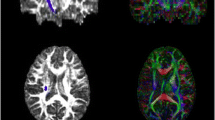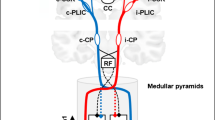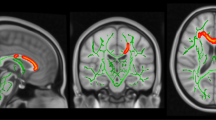Abstract
Using resting state (RS) functional magnetic resonance imaging (fMRI) and diffusion tensor imaging (DTI), we identified the predictors of clinical improvement following constraint-induced movement therapy (CIMT) in pediatric patients with chronic hemiplegia.From 14 children with congenital or acquired brain injury and 10 sex- and age-matched healthy controls, brain dual-echo, DTI and RS fMRI sequences were acquired before CIMT. The Quality of Upper Extremities Skills Test and the Gross Motor Function Measure (GMFM) were administered at baseline, at the end of CIMT (10 weeks), and after 6 months. Mean diffusivity and fractional anisotropy (FA) were measured in the lesion responsible for the clinical symptomatology, the affected and unaffected corticospinal tract (CST), motor transcallosal fibers, and uncinate fasciculus (as an internal control). Independent component analysis was used to identify the sensorimotor RS network. The ability of baseline MRI variables to predict clinical changes over time was assessed using multivariate linear models. At baseline, patients had increased mean diffusivity in the symptomatic lesion and decreased FA in the symptomatic lesion, affected corticospinal tract, and motor transcallosal fibers. A reduced RS functional connectivity was found in the bilateral cerebellum, left precentral gyrus, and right secondary sensorimotor cortex. At follow up, Quality of Upper Extremities Skills Test and GMFM scales improved significantly. Baseline average lesion FA predicted clinical improvement at week 10, and baseline functional connectivity of the right secondary sensorimotor cortex and cerebellum predicted GMFM improvement at month 6. DTI and RS fMRI offer promising and objective markers to predict clinical outcomes following CIMT in pediatric patients with congenital or acquired hemiplegia.

Similar content being viewed by others
References
Taub E. Movement in nonhuman primates deprived of somatosensory feedback. Exerc Sport Sci Rev 1976;4:335–374.
Walther M, Juenger H, Kuhnke N, et al. Motor cortex plasticity in ischemic perinatal stroke: a transcranial magnetic stimulation and functional MRI study. Pediatr Neurol 2009;41:171–178.
Glenn OA, Ludeman NA, Berman JI, et al. Diffusion tensor MR imaging tractography of the pyramidal tracts correlates with clinical motor function in children with congenital hemiparesis. AJNR Am J Neuroradiol 2007;28:1796–1802.
Yoshida S, Hayakawa K, Yamamoto A, et al. Quantitative diffusion tensor tractography of the motor and sensory tract in children with cerebral palsy. Dev Med Child Neurol 2010;52:935–940.
Holmstrom L, Lennartsson F, Eliasson AC, et al. Diffusion MRI in corticofugal fibers correlates with hand function in unilateral cerebral palsy. Neurology 2011;77:775–783.
Juenger H, Linder-Lucht M, Walther M, Berweck S, Mall V, Staudt M. Cortical neuromodulation by constraint-induced movement therapy in congenital hemiparesis: an FMRI study. Neuropediatrics 2007;38:130–136.
Facchin P, Rosa-Rizzotto M, Turconi AC, et al. Multisite trial on efficacy of constraint-induced movement therapy in children with hemiplegia: study design and methodology. Am J Phys Med Rehabil 2009;88:216–230.
Cimolin V, Beretta E, Piccinini L, et al. Constraint-induced movement therapy for children with hemiplegia after traumatic brain injury: a quantitative study. J Head Trauma Rehabil 2012;27:177–187.
DeMatteo C, Law M, Russell D, Pollock N, Rosenbaum P, Walter S. QUEST: Quality of Upper Extremity Skills Test Manual. Hamilton, Ontario: Neurodevelopmental Research Unit, Chedoke Campus, Chedoke-McMasters Hospital, 1992.
Russell DJ, Rosenbaum PL, Cadman DT, Gowland C, Hardy S, Jarvis S. The gross motor function measure: a means to evaluate the effects of physical therapy. Dev Med Child Neurol 1989;31:341–352.
Law M, Cadman D, Rosenbaum P, Walter S, Russell D, DeMatteo C. Neurodevelopmental therapy and upper-extremity inhibitive casting for children with cerebral palsy. Dev Med Child Neurol 1991;33:379–387.
Wang R, Benner T, Sorensen A, Wedeen V. Diffusion Toolkit: A Software Package for Diffusion Imaging Data Processing and Tractography. ISMRM abstract. Proc Intl Soc Mag Reson Med 2007;15.
Pierpaoli C, Basser PJ. Toward a quantitative assessment of diffusion anisotropy. Magn Reson Med 1996;36:893–906.
Catani M, Howard RJ, Pajevic S, Jones DK. Virtual in vivo interactive dissection of white matter fasciculi in the human brain. Neuroimage 2002;17:77–94.
Thomas B, Eyssen M, Peeters R, et al. Quantitative diffusion tensor imaging in cerebral palsy due to periventricular white matter injury. Brain 2005;128:2562–2577.
Ludeman NA, Berman JI, Wu YW, et al. Diffusion tensor imaging of the pyramidal tracts in infants with motor dysfunction. Neurology 2008;71:1676–1682.
Van Dijk KR, Sabuncu MR, Buckner RL. The influence of head motion on intrinsic functional connectivity MRI. Neuroimage 2012;59:431–438.
Calhoun VD, Adali T, Pearlson GD, Pekar JJ. A method for making group inferences from functional MRI data using independent component analysis. Hum Brain Mapp 2001;14:140–151.
Bell AJ, Sejnowski TJ. An information-maximization approach to blind separation and blind deconvolution. Neural Comput 1995;7:1129–1159.
Erhardt EB, Rachakonda S, Bedrick EJ, Allen EA, Adali T, Calhoun VD. Comparison of multi-subject ICA methods for analysis of fMRI data. Hum Brain Mapp 2011;32:2075–2095.
Himberg J, Hyvarinen A, Esposito F. Validating the independent components of neuroimaging time series via clustering and visualization. Neuroimage 2004;22:1214–1222.
Smith SM, Fox PT, Miller KL, et al. Correspondence of the brain's functional architecture during activation and rest. Proc Natl Acad Sci U S A 2009;106:13040–13045.
Maldjian JA, Laurienti PJ, Kraft RA, Burdette JH. An automated method for neuroanatomic and cytoarchitectonic atlas-based interrogation of fMRI data sets. Neuroimage 2003;19:1233–1239.
Brett M AJ, Valabregue R, Poline JP. Region of interest analysis using an SPM toolbox. Neuroimage 2002;16:372.
Oldfield RC. The assessment and analysis of handedness: the Edinburgh inventory. Neuropsychologia 1971;9:97–113.
Wolf SL. Revisiting constraint-induced movement therapy: are we too smitten with the mitten? Is all nonuse "learned"? and other quandaries. Phys Ther 2007;87:1212–1223.
French B, Leathley M, Sutton C, et al. A systematic review of repetitive functional task practice with modelling of resource use, costs and effectiveness. Health Technol Assess 2008;12:iii, ix-x, 1–117.
Hoare BJ, Wasiak J, Imms C, Carey L. Constraint-induced movement therapy in the treatment of the upper limb in children with hemiplegic cerebral palsy. Cochrane Database Syst Rev 2007:CD004149.
Wallen M, Ziviani J, Herbert R, Evans R, Novak I. Modified constraint-induced therapy for children with hemiplegic cerebral palsy: a feasibility study. Dev Neurorehabil 2008;11:124–133.
Pineiro R, Pendlebury ST, Smith S, et al. Relating MRI changes to motor deficit after ischemic stroke by segmentation of functional motor pathways. Stroke 2000;31:672–679.
Sterr A, Shen S, Szameitat AJ, Herron KA. The role of corticospinal tract damage in chronic motor recovery and neurorehabilitation: a pilot study. Neurorehabil Neural Repair 2010;24:413–419.
Drobyshevsky A, Bregman J, Storey P, et al. Serial diffusion tensor imaging detects white matter changes that correlate with motor outcome in premature infants. Dev Neurosci 2007;29:289–301.
Mark VW, Taub E, Morris DM. Neuroplasticity and constraint-induced movement therapy. Eura Medicophys 2006;42:269–284.
Sutcliffe TL, Logan WJ, Fehlings DL. Pediatric constraint-induced movement therapy is associated with increased contralateral cortical activity on functional magnetic resonance imaging. J Child Neurol 2009;24:1230–1235.
Lee JD, Park HJ, Park ES, et al. Motor pathway injury in patients with periventricular leucomalacia and spastic diplegia. Brain 2011;134:1199–1210.
Johansen-Berg H, Dawes H, Guy C, Smith SM, Wade DT, Matthews PM. Correlation between motor improvements and altered fMRI activity after rehabilitative therapy. Brain 2002;125:2731–2742.
Ramnani N, Toni I, Josephs O, Ashburner J, Passingham RE. Learning- and expectation-related changes in the human brain during motor learning. J Neurophysiol 2000;84:3026–3035.
Loubinoux I, Carel C, Pariente J, et al. Correlation between cerebral reorganization and motor recovery after subcortical infarcts. Neuroimage 2003;20:2166–2180.
Askim T, Indredavik B, Vangberg T, Haberg A. Motor network changes associated with successful motor skill relearning after acute ischemic stroke: a longitudinal functional magnetic resonance imaging study. Neurorehabil Neural Repair 2009;23:295–304.
Van Dijk KR, Hedden T, Venkataraman A, Evans KC, Lazar SW, Buckner RL. Intrinsic functional connectivity as a tool for human connectomics: theory, properties, and optimization. J Neurophysiol 2010;103:297–321.
Required Author Forms
Disclosure forms provided by the authors are available with the online version of this article.
Author information
Authors and Affiliations
Corresponding author
Additional information
Maria A. Rocca and Anna C. Turconi contributed equally to the study and should be considered joint first authors.
Electronic supplementary material
Below is the link to the electronic supplementary material.
ESM 1
(PDF 511 kb)
Rights and permissions
About this article
Cite this article
Rocca, M.A., Turconi, A.C., Strazzer, S. et al. MRI Predicts Efficacy of Constraint-Induced Movement Therapy in Children With Brain Injury. Neurotherapeutics 10, 511–519 (2013). https://doi.org/10.1007/s13311-013-0189-2
Published:
Issue Date:
DOI: https://doi.org/10.1007/s13311-013-0189-2




